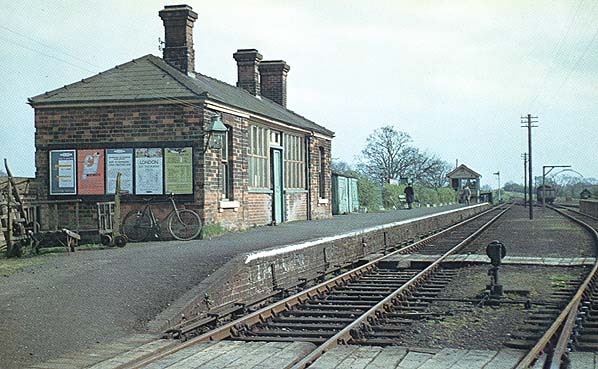
Station Name: COCKFIELD[Source:
Nick Catford]
old2.jpg) Cockfield station seen from the Howe Lane bridge in the early years of the 20th century. Note the posters on the wall, the top right poster says 'For sale - old railway carriage bodies £7'.
Photo from John Mann collection 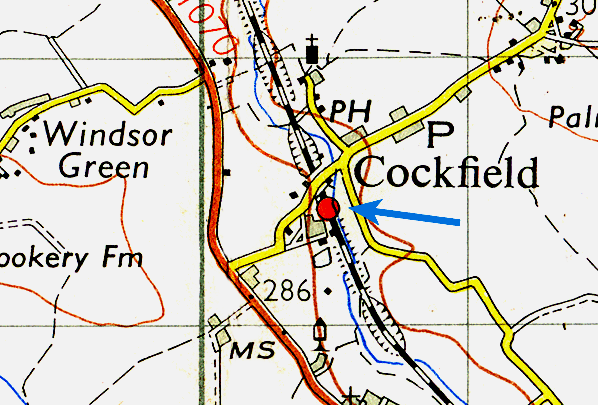  1885 1:2,500 OS map shows the layout of the station and goods yard with the dock shown to the west of the siding. Jennings' siding into Cockfield Hall is shown. At this time the station didn't have a signal box. 1885 1:2,500 OS map shows the layout of the station and goods yard with the dock shown to the west of the siding. Jennings' siding into Cockfield Hall is shown. At this time the station didn't have a signal box. 1904 1:2,500 OS map. A signal box has been provided at the end of the platform and a stationmaster's house to the north of the station has now also been provided
old3.jpg)
Cockfield station seen from the road bridge in the early years of the 20th century.
Photo from John Mann collection old4.jpg)
old5.jpg)
old6.jpg)
The last passenger train to stop at Cockfield station was a private charter on 4 June 1961. Between Long Melford and Lavenham this train was advertised as a 'Ramblers' Special' from Liverpool Street and carried a headboard 'The Last Train'. Once at Lavenham the train was used for a private excursion (organised by G.R. Lockie) running on to Bury St. Edmunds. It returned to Liverpool Street
by the same route. The goods dock is seen on the right 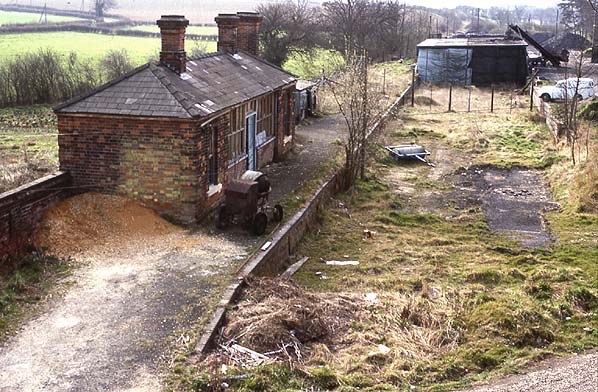
Cockfield
Station looking south in March 1976.
Photo by Nick Catford 3.jpg)
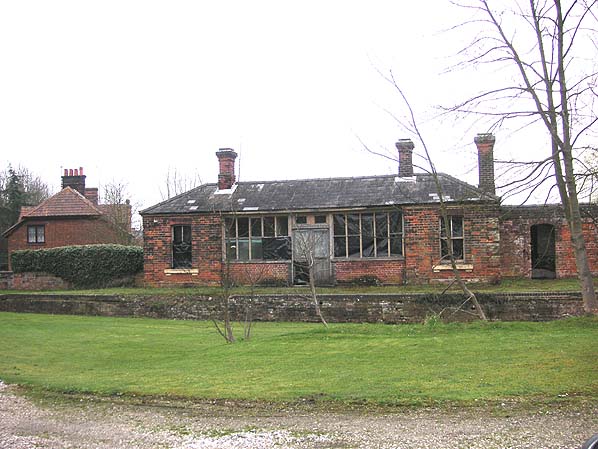
Cockfield
station seen from the former goods yard in April 2005.
Photo by Iain Addis 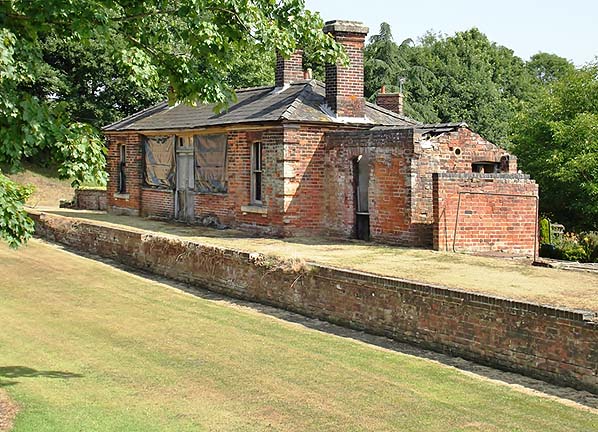
Cockfield station building in July 2013. The building has remained largely unchanged for 40 years, It has been weatherproofed by the current owner and is used for sold fuel storage, The gents' toilet is seen on the right. Photo
by Dave Carson 4.jpg)
Cockfield station looking south from Howe Lane in January 2024.
Photo by Martin Stubbins 5.jpg) Cockfield station building in Janyary 2024. The building has remained largely unchanged for 40 years. The track bed was neatly grassed in the early 2000s but has now been allowed to return to nature.
Photo by Martin Stubbins 6.jpg)
Cockfield station looking north in January 2024.
Photo by Martin Stubbins
 Home Page Home Page
|
 Cockfield handled a full range of goods traffic from the small yard opposite the platform, this comprised a single siding with a cattle dock. F J Jennings' private siding ran from the yard to the adjacent Cockfield Hall. The hall, which was demolished in 1888, was bought by the renowned Newmarket trainer Thomas Jennings in 1865 and turned into a stud farm. He built the southern block of the buildings for use as mares boxes with an exercise yard, and the eastern strip as a cart lodge with a granary over it. The western side was the working horse stables and chaff house. When the railway came through in 1870 a siding was provided terminating under it so that grain sacks could be lowered into wagons. The siding was also used for bringing in cattle from Wales and animal feed in the form of sugar beet pulp from Bury St Edmunds. The siding was taken out of use c1940 when a tank trap was dug all the way along the western side of the line as part of our wartime defences. This were backed up with the row of pillboxes manned by the Home Guard.
Cockfield handled a full range of goods traffic from the small yard opposite the platform, this comprised a single siding with a cattle dock. F J Jennings' private siding ran from the yard to the adjacent Cockfield Hall. The hall, which was demolished in 1888, was bought by the renowned Newmarket trainer Thomas Jennings in 1865 and turned into a stud farm. He built the southern block of the buildings for use as mares boxes with an exercise yard, and the eastern strip as a cart lodge with a granary over it. The western side was the working horse stables and chaff house. When the railway came through in 1870 a siding was provided terminating under it so that grain sacks could be lowered into wagons. The siding was also used for bringing in cattle from Wales and animal feed in the form of sugar beet pulp from Bury St Edmunds. The siding was taken out of use c1940 when a tank trap was dug all the way along the western side of the line as part of our wartime defences. This were backed up with the row of pillboxes manned by the Home Guard.  The line from Marks Tey to Sudbury opened on July 2nd 1849
but the extension to Bury St. Edmunds was not built. On January
1st 1854, the Eastern Counties Railway (ECR) took over the Eastern
Union Railway. Another company now emerged; the Sudbury &
Clare Railway which planned to make up for the failure of the
Stour Valley company to reach Bury St. Edmunds as approved in
the original 1846 Act. By an Act of July 1860, the Sudbury &
Clare Company was empowered to build a lone from Sudbury to
Clare via Melford. However, as soon as the powers were obtained,
the ECR took over and immediately sought extended powers to
build from Sudbury (via Melford) to Shelford on the London-Cambridge
main line, as well as the branch from Melford to Bury St. Edmunds.
The line from Marks Tey to Sudbury opened on July 2nd 1849
but the extension to Bury St. Edmunds was not built. On January
1st 1854, the Eastern Counties Railway (ECR) took over the Eastern
Union Railway. Another company now emerged; the Sudbury &
Clare Railway which planned to make up for the failure of the
Stour Valley company to reach Bury St. Edmunds as approved in
the original 1846 Act. By an Act of July 1860, the Sudbury &
Clare Company was empowered to build a lone from Sudbury to
Clare via Melford. However, as soon as the powers were obtained,
the ECR took over and immediately sought extended powers to
build from Sudbury (via Melford) to Shelford on the London-Cambridge
main line, as well as the branch from Melford to Bury St. Edmunds. 
 Lavenham was a small textile town but the industry was already
in decline when the railway opened. During the period prior
to the First World War, the line saw some of its best traffic.
The war brought little reduction in traffic but by the 1920s
the familiar pattern of road competition was setting in although
rail traffic continued quite healthily for some years; some
economies were made. After WW1 the economic decline of the area
deepened as did the population in many towns and villages in
the area together with traffic on the line. At its peak, there
were 5 or 6 trains a day between Bury and Long Melford with
2 or 3 of these continuing to Marks Tey or Colchester but this
was reduced in later years.
Lavenham was a small textile town but the industry was already
in decline when the railway opened. During the period prior
to the First World War, the line saw some of its best traffic.
The war brought little reduction in traffic but by the 1920s
the familiar pattern of road competition was setting in although
rail traffic continued quite healthily for some years; some
economies were made. After WW1 the economic decline of the area
deepened as did the population in many towns and villages in
the area together with traffic on the line. At its peak, there
were 5 or 6 trains a day between Bury and Long Melford with
2 or 3 of these continuing to Marks Tey or Colchester but this
was reduced in later years. Although passenger traffic showed some improvement, it was not
enough to overcome the increasing losses being incurred. Passenger
traffic between Long Melford and Bury St. Edmunds had become
very light and the line closed to passengers on April 10th 1961
with freight traffic surviving between Bury and Lavenham until
19.4.1965.
Although passenger traffic showed some improvement, it was not
enough to overcome the increasing losses being incurred. Passenger
traffic between Long Melford and Bury St. Edmunds had become
very light and the line closed to passengers on April 10th 1961
with freight traffic surviving between Bury and Lavenham until
19.4.1965.old7.jpg)
